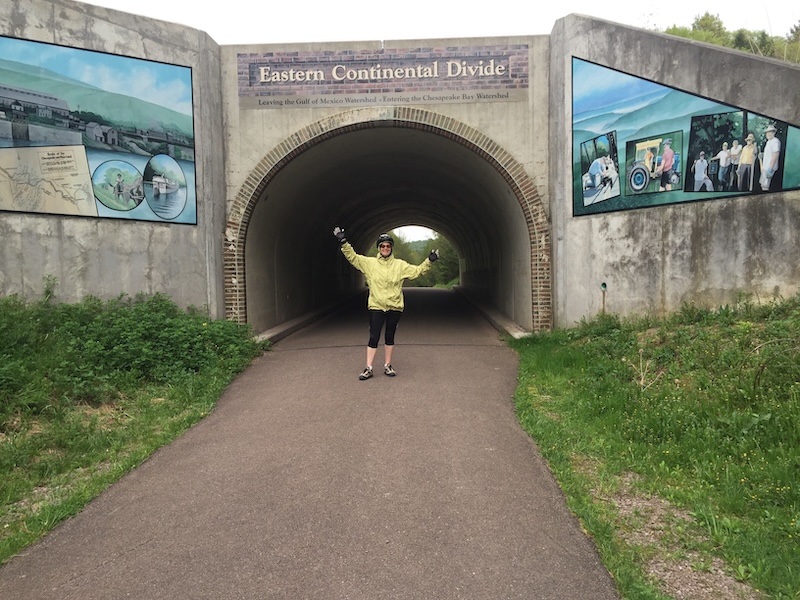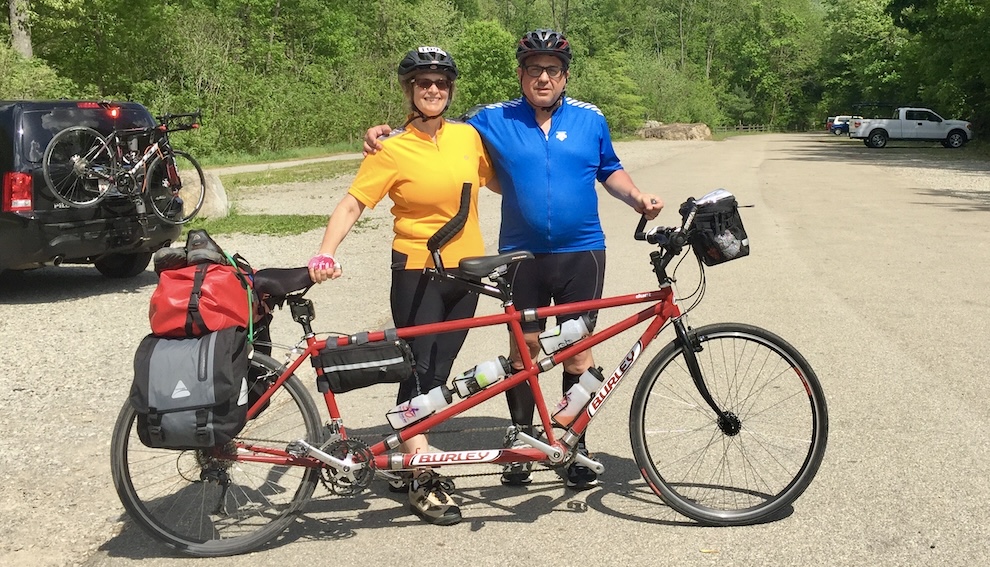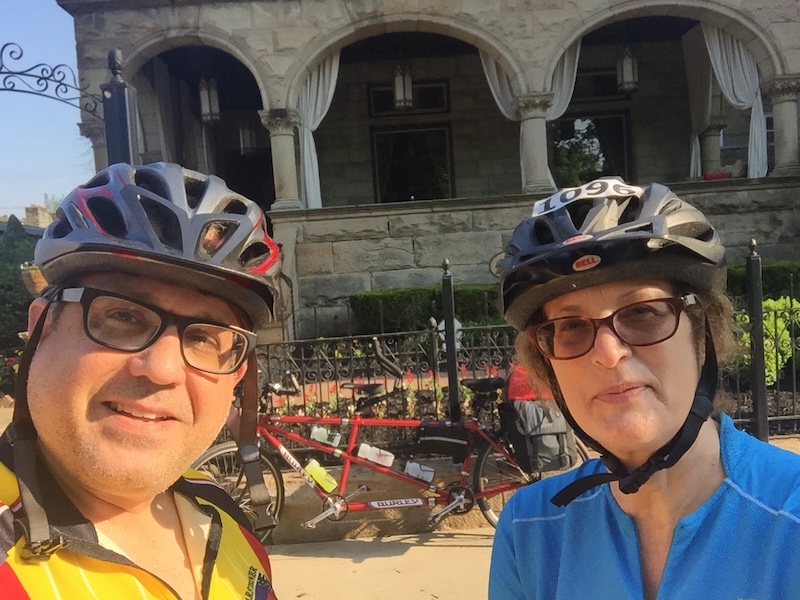Q&A with Susan Fader, FaderFocus
Editor’s note: Nancy Cox is the founder of Research Story Consulting and former CPG corporate researcher. Her work and play include words, sketchpads, cooking (not baking) and the occasional sock puppet.
Passions, hobbies, healthy distractions and even guilty pleasures – discover how the research community plays and how that plays out in their work life. In the Venn diagram of work and play, what happens when work and play overlap? Research colleagues share their work and play stories in this interview series by Nancy Cox.
Hello to Susan Fader, business strategist and qualitative research expert, FaderFocus
What is the “play” in your life?
I am a tandem stoker which means I am the person on the backseat of a bicycle built for two. Contrary to perception, the stoker is usually the strongest cyclist of the team, with their role acting as the pedaling engine. On the front seat doing the steering, shifting and braking is my husband.
We’ve always been cyclists. I grew up on a bike in New Jersey suburbia. My husband loves long-distance rides. So, as a long-time married couple planning to do something athletic and engaging together, a cycling vacation seemed natural. My husband agreed it was a great idea but pointed out that we have different cycling styles and if we rode separate bikes we would rarely be riding together. The solution – a tandem vacation.
Two Type As on one bike seemed like a recipe for disaster. However, my husband wanted to be in the front, and I readily agreed to be in back. As a mother and a business owner, I make decisions all day long. I welcomed a vacation from decisions! Off we went on our first self-guided tandem ride in the south of France. The travel company helped with lodging, portaged our luggage every day from village to village and provided a turn-by-turn paper map – this was before cycling apps were common. All was good until we saw our rented bike.
It was a very strange tandem! The brakes and gear shifters that were supposed to be in the front were in the back. First thing was not to get frustrated, but to work out our strategy for adaptation. So, we adapted. My husband stayed up front and we worked out a system where he gave me enough up-front warning of path conditions, needs for gear changes and braking with time to implement -- “we’re stopping, stopping, stopping, OK stop’ ‘we’re coming to a hill so we need to shift gears … now shift to 3.” Our first day we successfully covered 80 miles (30 more than in our original plan). Maybe we’re able to communicate so well now as a tandem couple because our first trip we really had to figure things out on the run.

We’ve continued with self-guided cycling rides, with some examples: the West Coast of Ireland; The Gap/C&O Canal Trail from Pittsburgh to Washington D.C.; Natchez Trace Trail in Tennessee and Mississippi; and the Greenbrier River Trail in West Virginia. We also ride an annual 400-mile supported tour – supported tours are scheduled events with many cyclists, often streets blocked off, plus prepared breakfasts, campsites, etc. – along the Erie Canal from Buffalo to Albany.
We both ride our separate bikes when we are home, but on cycling vacations, we love the tandem best because we can converse while riding. We appreciate how well we’ve blended our different styles of riding. I like to attack a hill. He likes to proceed slow and steady. But we must be together when we’re going to shift gears and when we are changing pedaling speed. My husband says tandem is the best marriage counseling and business partnership course.
Overcoming challenges is part of our adventures. In Ireland, we had a bike with a chain that kept coming off, we got stuck in a flock of sheep and almost missed the Aran Island ferry. Also in Ireland, we had a tire pop. The bike suddenly stopped so I had no time to respond and fell off the bike – my helmet cracked in three places, my face was bleeding and I was lying on a two-lane road with truck traffic. My husband picked me up and threw me into a bed of thistles – it was that or leave me on the highway!
We’ve had great fortune as well. There was a gift shop only 200 meters aways on that desolate stretch of Irish highway. On our C&O trail ride, we had three flat tires. We had already used our two packed tubes that day – and we have only had a total of five flat tires in all the years of tandem cycling! A young mom, walking the trail with her kids, loaded us in her husband’s new red pickup (“Don’t scratch it”) to take us into town. We’ve only turned around once. On the Greenbrier trail, we chose not to ride into an area with bear sightings and no cell phone reception.
How has your play influenced your research work?
Tandem has reinforced that all projects need to start with an accurate baseline assumption. But be open to the unscripted. I assumed I’d never drink brown water. On the Natchez Trace, there’s a 40-mile stretch with no stores, homes or any source of drinking water. We drank the five gallons of water we carried. Finally, we got to the National Park System’s water signed with “Even though the water is brown, it’s safe to drink.” Amazing what you will do when you’re really thirsty.
So much of life is scripted versus the unfolding of a new route. On the Cumberland Gap Trail, moments after we had a left a town behind, we saw 40 turtles sunning on a log. If I had already known I would see the turtles, I would have missed the excitement of surprise and discovery.
In daily life, our sensory gears get stuck. Being in nature restores sensing skills. In the woods, it takes time to really hear the many, many layers of sounds. Or noticing, yes, the forest is green but different shades of green. Noticing we haven’t climbed in altitude, yet the plants are different. What has changed – is it the soil? What are the smells? Rain coming? What’s the feeling of being comfortable in the ride and how can I make the other person feel comfortable? Exploring with all the senses. Making others comfortable. And sometimes, getting off your ass and really pumping! These are critical researcher skills that need to be renewed.
What would you tell readers who want to know more about your area of play?
First, try a one-day supported ride. Almost every state has supported rides such as one-day charity rides of 25 to 35 miles where it’s very safe with roads blocked off. Then try a longer supported ride like the Erie Canal Ride which is four or eight days covering up to 400 miles. “Rails to Trails bike rides” is a great search phrase to find well-mapped rides.
Enjoy the unscripted moments but be prepared. Always wear a helmet. Learn bike upkeep and repair. Do a few rides before you decide to purchase a tandem. You’ll need to know how you like to ride to determine gears, types of bags, etc. We needed a bike that would fit airline specifications, so we chose a custom-built coupled tandem that comes apart and can be packed into its two airline-friendly suitcases.
Finally, understand that the two people on the tandem don’t always have to agree but they must always work together.




